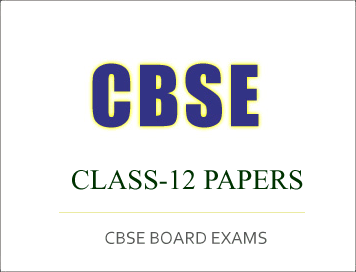CBSE Class-12 Question Papers for IOP/Comptt Examination 2017 : Delhi Scheme, Biology
Disclaimer: This website is NOT associated with CBSE, for official website of CBSE visit - www.cbse.gov.in

CBSE Class-12 Question Papers for IOP/Comptt Examination 2017 :
Delhi Scheme, Biology
CBSE Class-12 Question Papers for IOP/Comptt Examination 2017 : Biology, Set -1
BIOLOGY (Theory)
Time allowed : 3 hours
Maximum Marks : 70
General Instructions :
(i) There are total 26 questions in five sections in the question paper. All questions are compulsory.
(ii) Section A contains questions number 1 to 5, very short-answer type questions of 1 mark each.
(iii) Section B contains questions number 6 to 10, short-answer type I questions of 2 marks each.
(iv) Section C contains questions number 11 to 22, short-answer type II questions of 3 marks each.
(v) Section D contains question number 23, value based question of 4 marks.
(vi) Section E contains questions number 24 to 26, long-answer type questions of 5 marks each.
(vii) There is no overall choice in the question paper, however, an internal choice is provided in one question of 2 marks, one question of 3 marks and all three questions of 5 marks. In these questions, an examinee is to attempt any one question out of the two given alternatives.
SECTION – A
1. Name the stage of Plasmodium that gains entry into the human when bitten by an infected female Anopheles.
2. List any two characters of Pea plants used by Mendel in his experiments other than height of the plant and the colour of the seed.
3. Mention the role of Restriction Enzymes in Recombinant DNA technology.
4. Name the disorder caused due to the absence of one of the X-chromosomes in a human female.
5. Name the type of asexual reproduction where the parent cell ceases to exist.
SECTION – B
6. Name and state the effect of a drug that is often medically prescribed, but its overuse leads to drug dependence and drug abuse.
7. Differentiate between pericarp and perisperm.
8.“Niche is a part of a habitat.” Explain with the help of an example.
9.Name the type of immunity a baby is born with. How is it different from the one he gets from the mother’s milk after birth ?
10. State the roles of AUG codon at 5 end and UAG at 3 end of a certain m-RNA during translation.
OR
‘Degenerate’ and ‘Universal’ are salient features of a genetic code. Explain.
SECTION – C
11. Write the three basic facts that are highlighted in Mendel’s Law of Dominance.
12. (a) Name the causative agent of amoebiasis and mention its symptoms.
(b) Write how does it spread.
13. (a) What is green revolution ? Mention the steps that led to it.
(b) Name the scientist whose contribution led to development of semi-dwarf wheat varieties in India.
14. Are humming birds and fish regulators or conformers ? Give reasons in support of your answer.
15. GM plants are useful in many ways. How would you convince farmers to grow GM plants on their field ? Explain giving three reasons.
16. Name the male accessory glands in humans and write their functions.
17. Write in what context did Darwin use the terms ‘fitness’, ‘survival’ and ‘selection’ while elaborating on the mechanism of evolution.
18. State the objective with which a dairy farm is set up. Describe the essential steps to be followed for dairy farm management.
19. When Morgan conducted dihybrid cross on Drosophila like Mendel did with pea plants, the F2 ratios deviated significantly from that of Mendel’s F2 ratio. Write the explanation Morgan and his group gave to the observations they obtained from their
experiment.
20. Draw a diagram of a typical agarose gel electrophoresis showing migration of undigested and digested sets of DNA fragments. Label (a) the digested and undigested DNA fragments, (b) Anode and cathode ends of the plate. Mention therole of electrophoresis in biotechnology.